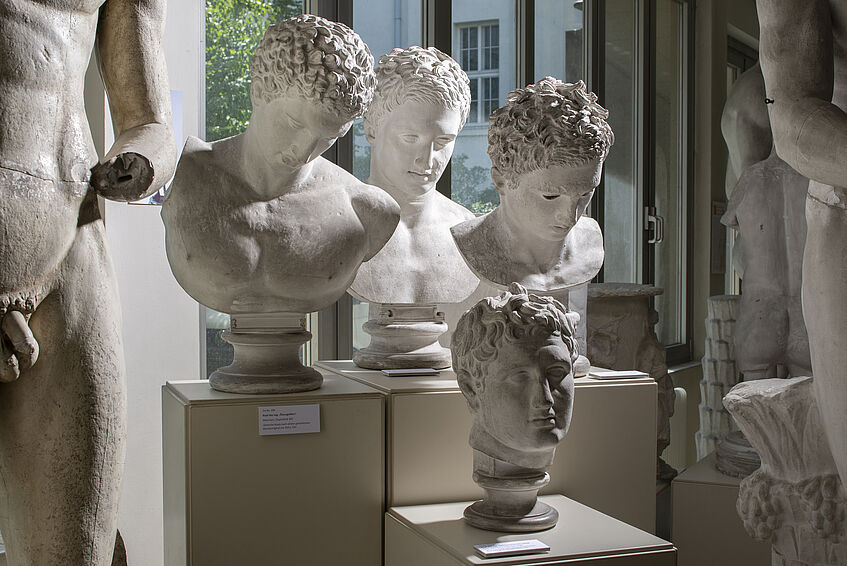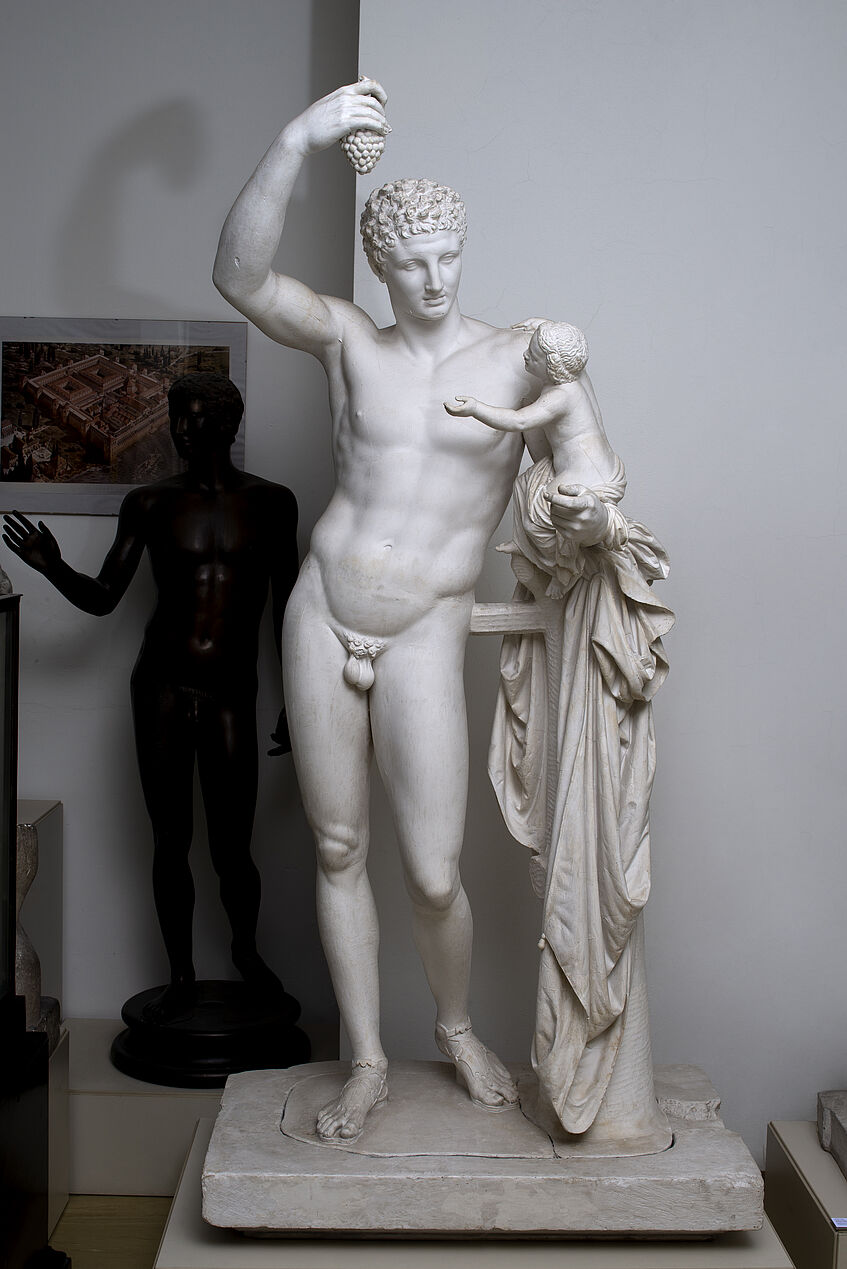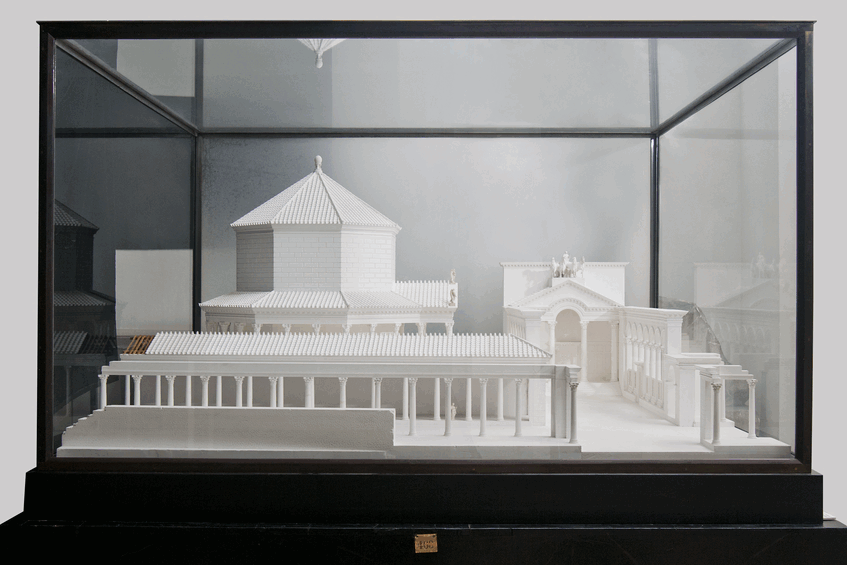
Busts in the Collection [IKA, photo: Kristina Klein]

Cast of the Olympia Hermes with reconstructions (no. 102a) [IKA, photo: Kristina Klein]

Frieze of the Heroon of Trysa [IKA, Photo: Kristina Klein]

Model of Diocletian’s Palace in Split (no. 955) [IKA, photo: Kristina Klein]
Collection of Plaster Casts
In the more than 150 years since its foundation, the Archaeological Collection has grown to over 1,200 plaster casts. It includes reproductions of statues from the Archaic to the Hellenistic periods, of Greek funerary and votive reliefs mainly from Classical Athens and Attica, but also of architectural sculpture from Greek temples from Asia Minor to Sicily and Magna Graecia. Besides, the collection holds casts of numerous Roman portrait busts, as well as partial or scaled reproductions of Greek sculpture. What informed the acquisition of plaster casts was the idea of providing a cross-section of Greek art, informing the idea of a ‘classical’ canon that was dominant at German-speaking and other European universities in the 19th and most of the 20th centuries.
The plaster cast collection was and still is primarily intended for teaching, but some objects point to specific research interests pursued at Vienna. This applies to several (partial) casts of the statue of Hermes and the infant Dionysos found at Olympia in 1877, which Otto Benndorf, the second Viennese Professor of Classical Archaeology, purchased to update his work on Praxiteles. The most prominent of these plaster casts, a reproduction of all surviving parts of the statue (no. 102a), was acquired from Berlin in 1881, and then conjecturally complemented at the Viennese Academy of Fine Arts by Karl Schwerzek, supervised by renowned sculptor Caspar von Zumbusch. The plaster cast thus shows a unique historical reconstruction imagining what a complete version of a newly-found statue might have looked like, and can only be seen in Vienna.
We also have an extensive cast collection of Lycian architectural sculpture, thanks to the long-standing fieldwork in Lycia (present-day Turkey), which the Austrian Archaeological Institute/Austrian Academy of Sciences continues to this day. Most prominent are the casts of the so-called Heroon of Trysa, a classical-period funerary monument with a complex relief frieze large parts of which are on display in the collection. With the consent of Ottoman authorities, Otto Benndorf dismantled the original slabs in 1882 and brought them to Vienna, where they are now stored in the Ephesus Museum. The plaster casts have their own historical biographies since most of them were made for the lecture in which Benndorf presented the sensational find to great applause from Viennese society in 1882. The Asia Minor Room also shows casts of the frieze of the so-called Heroon of Limyra and of several reliefs from Xanthos, as well as three models of monumental buildings from Limyra, namely of the Heroon, the Ptolemaion and the cenotaph of Augustus’ grandson Gaius Caesar. Shown as part of the Lycia exhibition at Schallaburg in 1889/90, the models are based on Jürgen Borchhardt’s excavation results and were made by a member of the University of Applied Arts.
Relevant to the history of archaeology are several architectural models which were designed as teaching aids. Among these is a model of a corner of the Athenian Parthenon (no. 721), acquired in 1896, which the Viennese sculptor Veit Matauschek made based on a drawing by architect and “Bauforscher” George Niemann and which can be partially taken apart. Matauschek’s handcraft and Niemann’s expertise are also manifest in a model of Diocletian’s Palace in Split (no. 955), which came from the Academy of Fine Arts to the collection in 1935. Of interest are also models of Greek column orders (no. 43–50), as well as reconstructions of the Olympia pediments (no. 600, 601) and of those from the Parthenon (no. 702, 779), the latter again made by Karl Schwerzek.
